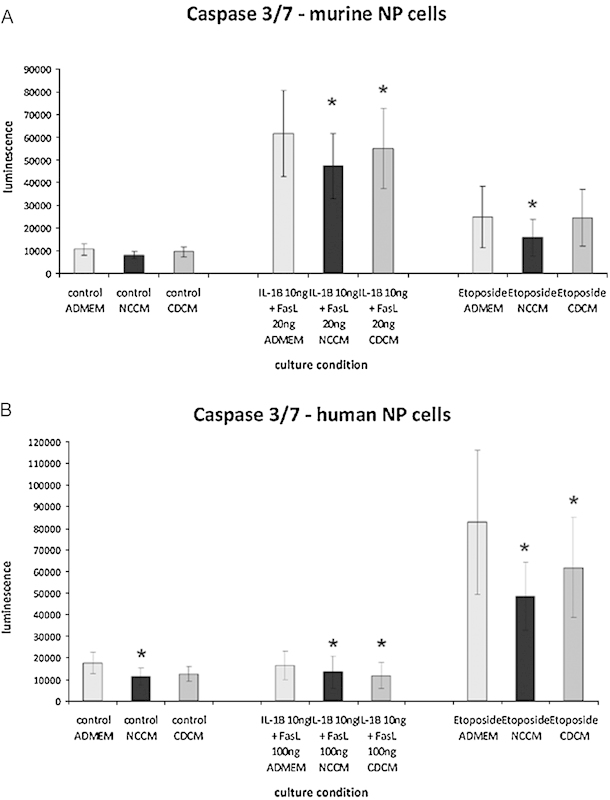犬脊索细胞分泌因子通过抑制活化的caspase-9和caspase-3/7保护鼠和人髓核细胞免于凋亡。
摘要
有效的治疗方法可能阻止或甚至逆转椎间盘退变仍然难以捉摸。一种能够获得髓核(NP)细胞活力的微创方法将彻底改变椎间盘退行性疾病(DDD)的治疗。在本研究中,我们研究了非软骨营养不良(NCD)犬椎间盘(IVD)衍生的脊索细胞条件培养基(NCCM)和软骨营养不良(CD)犬椎间盘(IVD)衍生的条件培养基(CDCM)是否能够保护小鼠和人类NP细胞免于凋亡。材料和方法我们分别从NCD和CD犬身上新分离的NPs进行缺氧培养,获得NCCM和CDCM。我们从9只不同的C57BL/6小鼠中获得小鼠NP细胞,从4名接受椎间盘切除术的患者中获得人类NP细胞。细胞用ADMEM/F-12(对照培养基)、NCCM或CDCM在缺氧条件下(3.5% O2)培养,并用IL-1β + FasL或依托泊苷处理。所有培养基均添加2%胎牛血清。然后,我们通过记录激活的caspase-8、caspase-9和caspase-3/7活性来确定小鼠和人NP细胞中特定凋亡通路的表达。结果在小鼠NP细胞中,NCCM通过抑制活化的caspase-9和caspase-3/7抑制IL-1β + FasL-和依托oposide介导的凋亡,CDCM通过caspase-3/7抑制IL-1β + FasL介导的凋亡(图1A)。在人NP细胞中,NCCM通过抑制活化的caspase-8、caspase-9,主要是caspase-3/7来抑制依托oposide介导的凋亡。CDCM通过抑制活化的caspase-8、caspase-9,主要是caspase-3/7,对依托oposide介导的细胞凋亡有抑制作用,但不如NCCM有效(图1B)。结论IL-1β + FasL是DDD进展的关键分子。在这里,我们证明了NCD IVD NP分泌的可溶性因子不仅可以保护小鼠NP细胞免受IL-1β + FasL的侵害,还可以通过抑制活化的caspase-9和caspase-3/7来保护依托oposide诱导的凋亡。在人体样本中,添加IL-1β + FasL不增加细胞死亡。由于人类细胞样本来自于可能已经经历退行性过程的椎间盘突出,因此很可能已经被内源性分泌的促退行性因子如IL-1β + FasL所激活。这可能是NP细胞,一旦它们达到退行性级联的关键点,就不再对外源性施加IL-1β + FasL作出反应,而不是从小鼠获得的“健康”椎间盘。有趣的是,NCCM对依托泊苷处理的细胞(小鼠和人)的拯救作用表明,NCCM能够影响已知与依托泊苷诱导的细胞死亡相关的信号通路。更好地理解和利用脊索细胞的恢复能力可能会导致新的细胞和分子治疗DDD的策略。

Introduction Effective therapies that may stop or even reverse disc degeneration remain elusive. A minimally invasive method through which nucleus pulposus (NP) cell viability could be achieved would revolutionize the treatment of degenerative disc disease (DDD). With the presented work, we have investigated if nonchondrodystrophic (NCD) canine intervertebral disc (IVD)-derived notochordal cell conditioned medium (NCCM) and chondrodystrophic (CD) canine IVD-derived conditioned medium (CDCM) are able to protect murine and human NP cells from apoptosis. Materials and Methods We developed NCCM and CDCM from hypoxic culture of freshly isolated NPs from NCD and CD canines, respectively. We obtained murine NP cells from nine different C57BL/6 mice and human NP cells from four patients who underwent surgery for discectomy. The cells were cultured with ADMEM/F-12 (control media), NCCM, or CDCM under hypoxic conditions (3.5% O2) and treated with IL-1β + FasL or Etoposide. All media were supplemented with 2% fetal bovine serum. We then determined the expression of specific apoptotic pathways in the murine and human NP cells by recording activated caspase-8, caspase-9, and caspase-3/7 activity. Results In the murine NP cells, NCCM inhibits IL-1β + FasL- and Etoposide-mediated apoptosis via suppression of activated caspase-9 and caspase-3/7, CDCM demonstrated an inhibitory effect on IL-1β + FasL-mediated apoptosis via caspase-3/7 (Fig. 1A). In the human NP cells, NCCM inhibits Etoposide- mediated apoptosis via suppression of activated caspase-8, caspase-9, and mainly caspase-3/7. CDCM demonstrated an inhibitory effect on Etoposide-mediated apoptosis via suppression of activated caspase-8, caspase-9, and mainly caspase-3/7, though not as effective as NCCM (Fig. 1B). Conclusion IL-1β + FasL are known key molecules in the progression of DDD. Here, we demonstrate that soluble factors secreted by the NCD IVD NP strongly protect murine NP cells not only from IL-1β + FasL but also from Etoposide-induced apoptosis via suppression of activated caspase-9 and caspase-3/7. In the human samples, addition of IL-1β + FasL did not increase cell death. Because the human cell samples were obtained from herniated discs that are probably already undergoing a degenerative process, it is likely that there was already some degree of activation by the endogenously secreted prodegenerative factors such as IL-1β + FasL. It may be that the NP cells, once they have reached a pivotal point of the degenerative cascade, no longer respond to exogenously applied IL-1β + FasL in contrast to the otherwise "healthy" discs obtained from the mice. Interestingly, the rescue effect of NCCM in the etoposide-treated cells (murine and human) suggests that NCCM is capable of influencing the signaling pathways known to be relevant to etoposide-induced cell death. A better understanding and harnessing of the restorative powers of the notochordal cell could lead to novel cellular and molecular strategies for the treatment of DDD.

 求助内容:
求助内容: 应助结果提醒方式:
应助结果提醒方式:


